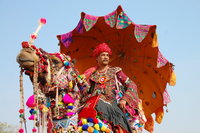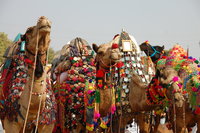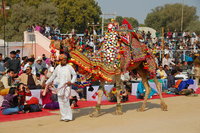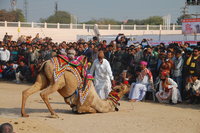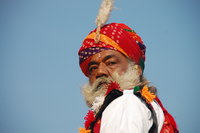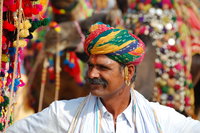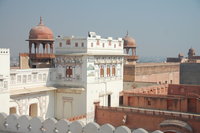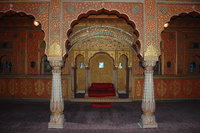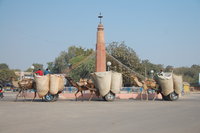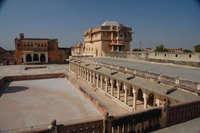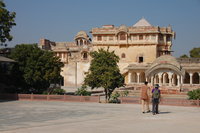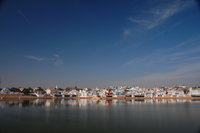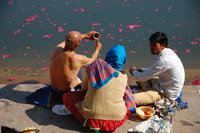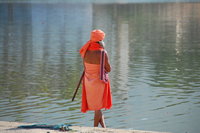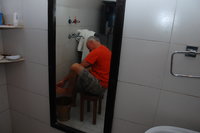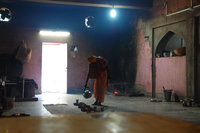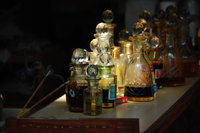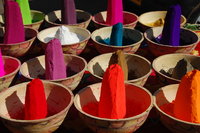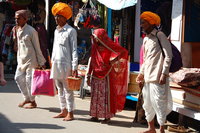The border-hugging, cross-desert trip from Jaisalmer to Bikaner is about 330km either by road or rail. Despite the on-line booking sites showing that no trains ply this route, we discovered a local mail train that runs once a day and we were determined to give it a go. It was scheduled to take 6½ hours and costs a massive £1.50 each. When the hotel staff in Jaisalmer discovered our intentions, they invested a large amount of time trying to persuade us not to do this. They insisted that we should take the bus (or even hire a private driver - £40) and they had two main arguments to back this up. Firstly, at this time of year, there is a possibility of fog. If this occurs, then the train can be delayed. Apparently, the buses never get delayed by the fog! You can draw your own conclusions as to whether this should be considered "advantage bus" or not. The second argument seemed to be that the train was a rather stop-start affair. They communicated this by making stylised chuffing noises and pistoning their arms rather like a steam locomotive. The volume and speed of the sounds and gestures we assumed indicated that the train would periodically speed up, slow down and stop completely. This was fine by us and rather what we expected (especially if it was foggy). Imagine our surprise when, upon finally departing Jaisalmer, we discovered that the train actually did emit this exact chuffing noise. We are not sure why, as it was most definitely diesel.
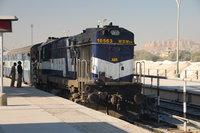
What the hotel owners omitted to tell us (and it might actually have been an effective argument) is that this train is principally used by the armed forces to move up and down the border. Given the heightened tension in this area at the moment, perhaps this was not the best form of transport to take. Of course, the real motivation for their efforts was to gain some commission, which they could not if we bought our tickets at the railway station.
About half an hour into the journey and our carriage was overwhelmed by an incredibly foul stench. We all looked at each other in a way that simultaneously communicated that a) we understand malodorous occurrences are common on Indian trains and b) this particular odour was completely unacceptable. Shortly thereafter, the train ground to a halt, perhaps indicating that the driver felt the same way. As is usual when a train stops anywhere along the route, everyone got off and started milling around in the desert. Eventually we discovered that we had hit a camel and pushed it quite some way along the track and that this was the source of the noxious event. Despite having ridden camels quite recently and witnessed at first hand their ability to be pungent, our knowledge of their insides is insufficient to figure out whether the camel was already dead when we hit it. What we did conclude, of course, is that the fog argument was specious since there wasn't a wisp of mist and we still ploughed into the largest animal around.
Despite all of the above, we arrived in Bikaner bang on time; £1.50 well spent!
Having killed a camel en route to Bikaner, we wondered whether there would be a gap in the procession at the annual Bikaner Camel Fair (which is the main reason we came here).
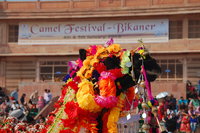
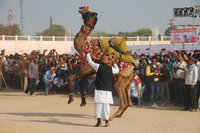
The fair is billed as starting with a procession from the old fort (surprise!) through town to the stadium where there would be a further procession followed by a best dressed camel competition. After this would be more processions and some camel dancing (!) followed by a camel hair-cutting competition. We could eat camel kulfi (ice-cream), drink camel milk and purchase camel crafts and merchandise (a theme is emerging here). Additionally, there was to be a Miss Bikaner competition. It is not clear what it says about the young women of this city that their beauty contest is held during a camel fair and far be it from us to comment.
It was certainly fun to wander amongst the brightly decorated camels waiting for the parade to start. It was always worth keeping an eye out when looking at one camel to ensure there wasn't another one planning to relieve itself right behind you (they have a certain height advantage)! In the stadium, whilst we waited for the procession to arrive, a compare regaled us with information about camels, Bikaner and the glorious and brave Indian army in the most flowery and ridiculously Victorian English... "the vaingloriously and exceptionally diligently decorated of these magnificent beasts will most surely permeate your memory lane very dramatically and with permanence, that is definitely the case". Apparently the 1000km border with Pakistan is patrolled by these animals and that is why there is peace and security - who knew?
Rather like the camel safari we went on in Jaisalmer, the Bikaner camel fair also included a "cultural program". This time, however, it was "an absolutely splendid and wonderful display of the magnificent and tremendous Indian heritage". Translated from flowery, colonial bureaucracy speak into English, it comes out as something like; badly choreographed oafs lurching around on stage in bright costumes accompanied by ludicrously over-amplified and distorted music and more flashing lights than an Olympic opening ceremony. That said, we enjoyed watching dances from the various states of India and also traditional fire dancing (jumping on hot coals) plus free fireworks. We have not included any photos of the cultural program for fear of making it look better than it actually was. We should also say that the entire festival was sponsored by one of the banks here who obviously have more sense of community than the criminals who run the British banks. The festival was free to all comers and foreigners were made most welcome.
Often, when visiting palaces, we have seen dusty old photographs of the Maharajas and their entourages lined up in rows resplendent in finery with turbans and swords. Always, somewhere in the middle of the front row is an uncomfortable looking English gentleman in a safari suit who is invariably labelled as "The Viceroy". At the camel fair, there were rows of seats at the front allocated to local dignitaries to afford them the best view of the camel related proceedings. Should you ever come across a dusty old photo of the 2015 Bikaner Camel Fair in a museum somewhere, look closely at the middle of the front row for a couple of sand-covered Brits!
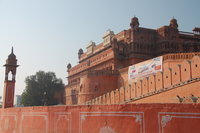
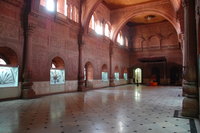
There's a fort here. We won't go on about it other than to say it claims never to have been successfully attacked (this might sound familiar). It was slightly unusual insomuch as it is not built on top of a local hill to make use of the cliffs for defence. This is not so much a design feature, more because there simply aren't any hills. Inside it was one of the most impressively decorated forts we have seen to date.
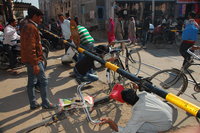
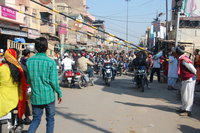
We spent quite some time wandering the streets of Bikaner and witnessing the craziness that seems to permeate the locals. For the first time ever we witnessed complete gridlock caused simply by people with bicycles. We are still in the desert here but, unlike in Jaisalmer, the dust makers are out in force to back up the efforts of nature.
Despite being very dry, there is still a foetid nature to the air; perhaps it is this that makes the people here a bit weird. When confronted by a level crossing, those with enough self discipline to actually wait for the train to pass and the barriers to lift will occupy both sides of the road in their effort to get as close to the front as possible. When the barriers raise, everyone sets off immediately only to meet an oncoming wall of traffic. Everyone grinds to a halt on the tracks. Regardless of the camel fair, we had not expected to see so many working camels here. They are a regular sight in the streets and don't seem to pay any attention to the rest of the traffic or the mad locals. They also tend to wait for the level crossing barriers to lift too, rather than trying to limbo underneath (which would be a sight, of course).
We chose our hotel in Bikaner due to its location directly opposite the camel fair and it worked out well in that regard. In pretty much every other respect though, it was rubbish. Rather strangely, the hotel restaurant was decked out like a Swiss chalet. As if to lend authenticity, we met a Swiss couple on the first evening in this very restaurant; they were quick to inform us that they had waited 52 minutes for their food. Those Swiss chronometers eh? The hotel staff made Basil Fawlty look like Mastermind. We ordered toast and jam for breakfast and got a toasted jam sandwich. They hid our clothes when cleaning the room (actually, that's all they did). The manager went out one day and got so drunk he was barely able to ride his motorcycle back to the hotel (or stand up). On the last morning they kept us waiting 45 minutes for breakfast which meant we nearly missed our train. Megan declared it the worst hotel in India, which might be rather overstating our experience "in country", but is a good working hypothesis. The Swiss must have found it even more frustrating than we did.
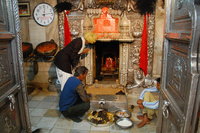
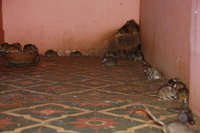
We took a day trip out by local government bus to the Rat Temple at Deshnok. Now, you would have to be some kind of hopeless, romantic optimist to think that anything associated with rats in India is going to be even slightly pleasant. Apparently, the Rat Temple is "world famous" - infamous more like. Most of the temples we have seen in India have suffered to some degree from pigeon infestation, which leaves white stripes down everything, an unpleasant smell and a sticky residue under foot. This problem is compounded by our having to remove shoes (and socks in some cases) in order to enter the places. At Deshnok, this problem is exacerbated by the presence of thousands of filthy, mangy and diseased rats. Local legend has it that when the inhabitants of Deshnok die, they return as rats and when the rats die they return as local residents; repeat to fade. Of course, we treated this legend with the scepticism it deserves. We vowed never to return to Deshnok.
The next day, we returned to Deshnok. Upon departing Bikaner, our train stopped there again. A local fellow got on. Imagine our surprise to observe the buck teeth and pointed features that reminded us of a rat. Weird!
On the way to Pushkar, we stopped off in Nagaur to see...you guessed it, a fort. We'll not go on about it here, but there are some photos below. Nagaur is a real Indian town that tourists don't really go to. We stayed in an Indian businessman's hotel which meant most of the rooms we were shown were littered with empty whiskey bottles. We thought if we were to get ill anywhere it would probably be here, but the food turned out to be excellent even though the prices were higher on the English version of the menu than the Hindi one. Imagine trying to get away with that in the UK!
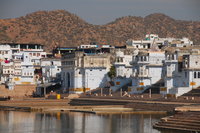
The town of Pushkar lies on the banks of the holiest lake and one of the most sacred sites in the whole of India! Apparently Lord Brahma the Creator chucked a lotus flower here and water miraculously appeared. What miraculously appears nowadays is a priest offering to pray for you (for a fee of course). The lake draws pilgrims (and people who don't have a shower at home) by the hundreds every day. On full moon during the Winter months, thousands come to bathe in the lake and be cured of all ills. One can understand why this would be popular, since there are so many ills to choose from in India.
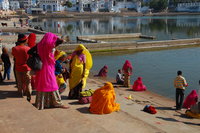
There are 50-odd ghats (steps leading down to the water) lining the banks of the lake and apparently 500 temples, which is easy to believe. The holiness of the place these days is unquestionable as far as the Indian visitors are concerned, but for the local residents the place has naturally taken on a rather commercial aspect. There are hundreds of little shops supplying all the trinkets a devout worshipper could possibly need. Apparently the proceeds pay for the priests who are otherwise unpaid.
The lake also draws the ubiquitous pigeon (not to mention the cow of course) and this coincides yet again with the requirement to remove footwear when visiting the holy places. It is a curiosity that Indians come here to bathe and be cleansed, whereas we have to bathe once we have left!
Once a year, Pushkar hosts the world's largest camel fair. Fresh from our camel (and rat) experiences, we were relieved to find we had missed it!
In addition to the Indian tourists, there is a significant contingent of westerners keen to see what all the fuss is about. As a result, local commerce has taken on a western gringo slant with numerous cyber-cafés, banana pancake houses and coffee shops boasting real coffee. Needless to say, we availed ourselves of the latter. In fact, we took the time here to recharge a bit since some home comforts are available. For the first time in India and to Megan's delight, we had an electric heater in our room. This delight was tempered somewhat when we discovered that the electricity spent more time off than on.
Now we continue our easterly trek away from Pakistan. Next time, we will be in Jaipur...where they have Swine Flue. Stay safe!
